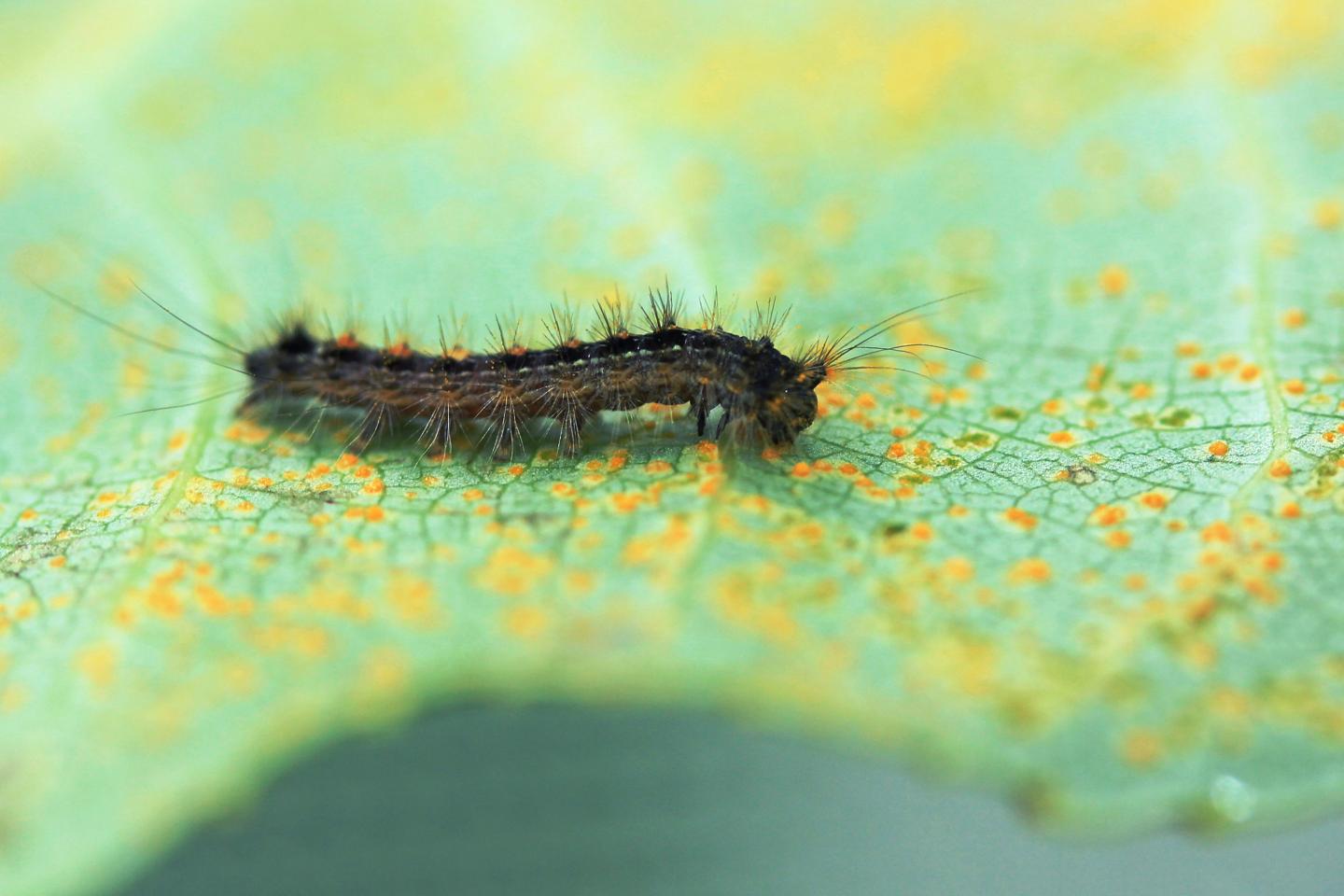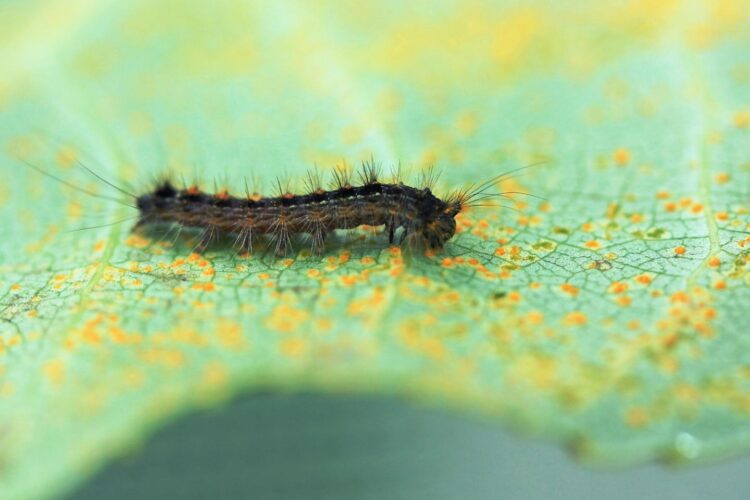Gypsy moth larvae love poplar leaves infected by fungi

Credit: Franziska Eberl, Max Planck Institute for Chemical Ecology
Black poplar leaves infected by fungi are especially susceptible to attack by gypsy moth caterpillars. A research team at the Max Planck Institute for Chemical Ecology in Jena, Germany, has now further investigated this observation. The scientists found that the young larvae of this herbivore upgrade their diet with fungal food: Caterpillars that fed on leaves covered with fungal spores grew faster and pupated a few days earlier than those feeding only on leaf tissue. The higher concentrations of important nutrients in fungi, such as amino acids, nitrogen and vitamins, are probably the reason for their better performance. The results shed new light on the co-evolution of plants and insects, in which fungi and other microorganisms play a much greater role than previously assumed (Ecology Letters. DOI: 10.1111/ele.13506).
Gypsy moth caterpillars are known as feeding generalists; this means they accept a large variety of deciduous trees species and shrubs as their food plants. Outbreaks of this species have been documented every now and then also in German forest ecosystems.
Sybille Unsicker and her research team are investigating how poplars defend themselves against herbivores, including the gypsy moth. The scientists had observed that these trees downregulate their defense against the voracious insect when they are simultaneously being attacked by fungi. “We noticed that caterpillars are attracted by the odor of fungus-infested poplars, so we wondered why this is so: Would the caterpillars prefer to feed on infested leaves as well? Would this provide an advantage? And if so, what kind of chemicals are responsible for this?” first author Franziska Eberl asks, describing the basic questions of the study.
Feeding experiments in which the gypsy moth larvae were offered a choice of leaves with or without fungal infection revealed the clear preference of the caterpillars for leaves infected with fungi. In the early larval stage, they even consumed the fungal spores on the leaf surface before feeding on leaf tissue. “Whether rust fungi or mildew, young caterpillars selectively fed on the spores and preferred to feed on infected leaves,” explains Franziska Eberl. Chemical analyses showed that mannitol, a substance that is also used as an artificial sweetener in human food, is primarily responsible for this preference. Eberl also monitored larval fitness, which is shown by how well larvae develop – a measurement that depends largely on their diet. “Larvae that consume fungus-infected leaves develop faster and also pupate earlier. This gives them an advantage over their siblings who feed on healthy leaves. Important nutrients, such as amino acids, nitrogen and B vitamins, are likely responsible for increased growth, because their concentration is higher infected leaves,” said the researcher.
The role of microorganisms puts the co-evolution of plants and insects in a new light
The observation that an insect classified as an herbivore is actually a fungivore – at least in its early larval stage – was a real surprise for the research team. “Our results suggest that microorganisms living on plants might have a more important role in the co-evolution of plants and insects than previously thought,” says Sybille Unsicker, head of the study. “In the black poplar trees from our study, fungal infestation occurs every year. It is therefore indeed imaginable that herbivorous insects have been able to adapt to the additional fungal resource. Especially with regards to the longevity of trees, the evolutionary adaptation to a diet consisting of leaves and fungi seems plausible for such insects”.
Further investigations are needed to clarify how widespread fungivory is in other herbivorous insect species and what influence the combination of plant and fungal food has on the immune system of insects. It is possible that this food niche also has an effect on the insects’ own defense against their enemies, such as parasitoid wasps. The role of microorganisms in the interactions between plants and insects has long been underestimated, even overlooked. This study is an important step to make up for that neglect.
###
Original Publication:
Eberl, F., Fernandez de Bobadilla, M., Hammerbacher, A., Reichelt, M., Gershenzon, J., Unsicker, S., (2020). Herbivory meets fungivory: Insect herbivores feed on plant pathogenic fungi for their own benefit. Ecology Letters. DOI: 10.1111/ele.13506
https:/
Download of high-resolution images and videos via http://www.
Media Contact
Sybille Unsicker
[email protected]
Original Source
http://www.
Related Journal Article
http://dx.





